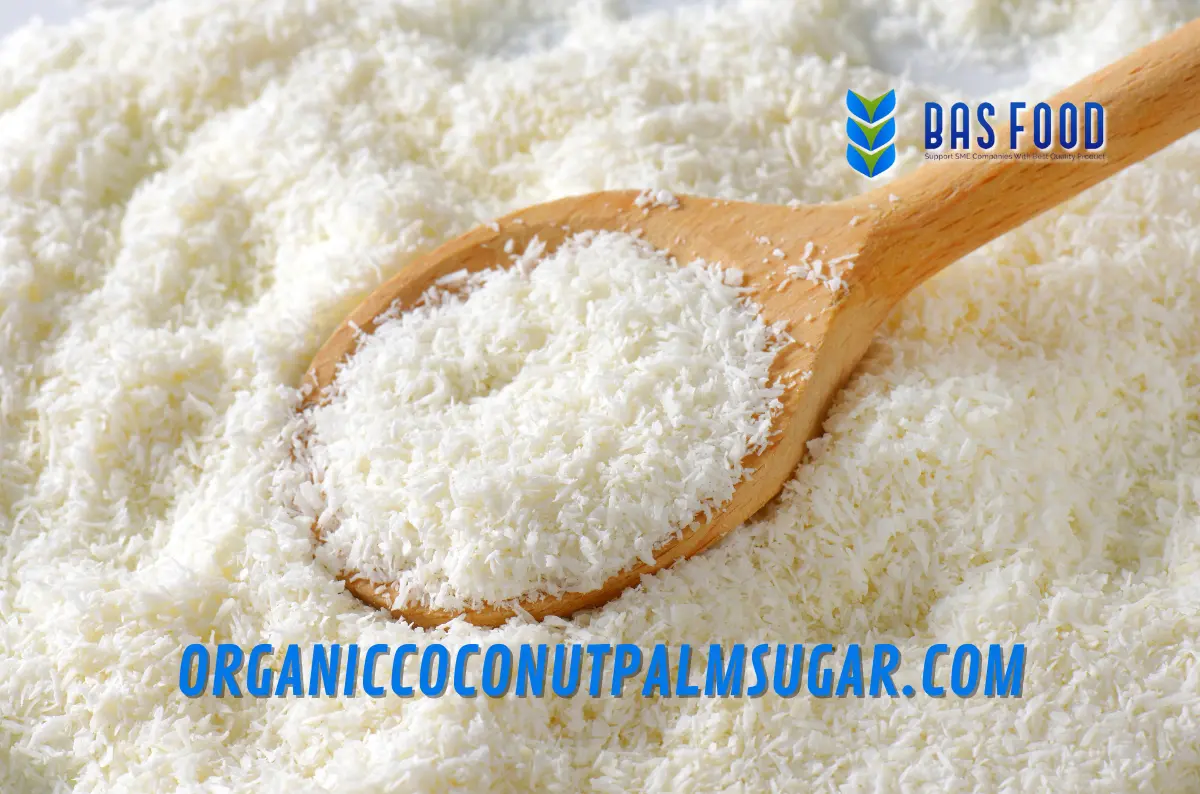When people talk about dried coconut, they might imagine shredded coconut used in baking or the fine coconut powder found in smoothie mixes. However, the world of dried coconut is far more diverse, with various types of dried coconut available. From desiccated coconut to coconut chips and coconut flour, each type is designed for specific food and industrial applications.
In essence, the types of dried coconut are categorized based on texture, fat content, and intended use. Some are ideal for confectionery and bakery purposes, while others are perfect for beverages, sauces, or health foods. What’s fascinating is that the same raw material — the humble coconut — can be transformed into a wide variety of shelf-stable products through different drying techniques.
Today, dried coconut isn’t just an ingredient. It’s an essential global commodity that supports thousands of smallholder farmers and export producers — especially in tropical regions like Indonesia, where companies like CV Bonafide Anugerah Sentosa produce and supply high-quality coconut derivatives for international markets.

Desiccated Coconut: The Star of Dried Coconut Products
Among all types of dried coconut, desiccated coconut is arguably the most well-known. It’s made by grating the white coconut meat, then carefully drying it at controlled temperatures to preserve its flavor and aroma. This process results in pure, unsweetened coconut with a naturally long shelf life.
Desiccated coconut is often classified based on particle size, which directly affects its texture and culinary use. The two main grades are fine cut and medium cut, often referred to as fine vs medium cut coconut. Fine-cut desiccated coconut blends smoothly into doughs and batters, making it perfect for cakes, cookies, and desserts. Meanwhile, medium-cut varieties retain more texture, making them great for toppings or fillings where a stronger coconut bite is desired.
The distinction between fine vs medium cut coconut might sound minor, but for food manufacturers, this difference determines mouthfeel, texture, and even how well the product absorbs moisture — all crucial for achieving consistent quality in food production.
Coconut Powder and Its Fat Content: High Fat vs Low Fat Explained
Moving beyond grated coconut, we come to coconut powder — another versatile dried form. Coconut powder is made by spray-drying coconut milk or dehydrating ground coconut meat until it becomes a smooth, free-flowing powder. It’s popular in beverage mixes, sauces, and dairy alternatives because it reconstitutes easily with water.
One of the most important distinctions here is fat content — specifically, high fat coconut powder vs low fat coconut powder.
High fat coconut powder typically contains around 60–65% oil. It delivers a rich, creamy flavor that’s ideal for premium recipes like vegan desserts, curries, and instant coconut milk drinks.
Low fat coconut powder, on the other hand, usually contains less than 50% fat. It’s lighter, less oily, and used in applications where reduced calories or fat levels are preferred — such as in health foods, protein bars, or low-fat baked goods.
The choice between high fat coconut and low fat coconut depends largely on your product’s nutritional target and mouthfeel. Food formulators often experiment with both to achieve the right balance between creaminess and stability.
Coconut Classification: Understanding Grades and Quality Standards
Just like coffee beans or spices, dried coconut products are also subject to coconut classification systems. These classifications ensure that the products meet international quality standards for export, storage, and food safety. Grading typically considers moisture content, fat content, color, particle size, and purity.
Here’s a simplified look at how coconut classification usually works:
- Grade A: Premium quality, snow-white color, very low moisture (<3%), no specks, and ideal aroma. Perfect for high-end food products.
- Grade B: Slightly off-white, with minor specks, still suitable for general food applications.
- Grade C: Used for industrial applications, often darker and less refined.
Exporters like CV Bonafide Anugerah Sentosa prioritize Grade A desiccated coconut for their clients in Europe, the USA, and Asia — ensuring consistency, safety, and excellent taste. Their coconut products undergo strict quality control, from raw material selection to final packaging.
It’s this commitment to classification and standardization that makes Indonesian dried coconut highly competitive in the global market.
Other Popular Types of Dried Coconut Products
Beyond desiccated coconut and powder, there are several types of dried coconut worth exploring — each with its own niche uses.
- Coconut Chips: Thinly sliced coconut meat toasted to crisp perfection. Ideal for snacks, granolas, and toppings.
- Coconut Flakes: Larger cuts of dried coconut that give a chewy texture, often used in cereals, confectioneries, or decorative bakery toppings.
- Coconut Flour: Made from defatted coconut meat after oil extraction. It’s gluten-free and high in fiber, making it a favorite among health-conscious consumers.
- Coconut Milk Powder: Created through spray drying coconut milk, providing a convenient, shelf-stable alternative to liquid coconut milk.
Each type adds unique flavor, texture, and nutritional value. Together, they represent the versatility of coconuts as a sustainable crop. What’s even better is that almost every part of the coconut — from its water to its shell — can be transformed into a valuable product.
The Global Market and Demand for Dried Coconut
The demand for dried coconut products continues to grow worldwide. With increasing consumer interest in plant-based diets, vegan products, and natural ingredients, dried coconut fits perfectly into this trend. It’s non-GMO, gluten-free, and naturally rich in healthy fats and minerals.
Countries like the USA, Germany, Japan, and Australia import large volumes of dried coconut each year for use in confectionery, bakery, snacks, and health food industries. Meanwhile, Southeast Asia — particularly Indonesia, the Philippines, and Sri Lanka — leads global production.
As a leading coconut supplier and exporter from Indonesia, CV Bonafide Anugerah Sentosa plays an important role in this value chain. The company not only provides dried coconut products but also other natural commodities such as spices, fishery products, and coffee. Their integrated sourcing and production network ensures consistent supply, high quality, and competitive pricing — making them a trusted partner for importers worldwide.
Choosing the Right Type of Dried Coconut for Your Business
If you’re in the food industry, choosing the right type of dried coconut can make a big difference in your product’s quality. Start by identifying your end application — are you producing snacks, baked goods, or beverages? Then, consider key parameters such as texture (fine vs medium cut coconut), fat content (high vs low fat), and grade (A, B, or C).
For instance:
- Fine desiccated coconut works best for smooth-textured products like cookies or cakes.
- Medium cut coconut suits textured products like granola bars.
- High fat coconut powder adds rich creaminess to sauces and desserts.
- Low fat coconut powder helps reduce calories in health-oriented recipes.
Partnering with an experienced exporter like CV Bonafide Anugerah Sentosa ensures you get the right specification and documentation for your market. Whether you need high-fat desiccated coconut for Europe or low-fat coconut powder for Japan, the company can tailor its products to your needs.
Why Indonesia Is a Global Leader in Coconut Production
Indonesia has long been recognized as one of the world’s top coconut producers, thanks to its tropical climate, fertile soil, and skilled labor. The country’s coconut industry supports millions of small farmers, contributing significantly to rural economies.
Companies like CV Bonafide Anugerah Sentosa bring local expertise to the global stage by adhering to international food safety standards, including HACCP and ISO certification. Their factories combine traditional coconut processing knowledge with modern drying and packaging technologies — resulting in premium dried coconut products suitable for global export.
This unique balance of heritage and innovation has positioned Indonesia as a powerhouse in the global coconut supply chain.
The Sustainable Future of Dried Coconut Products
As sustainability becomes a key concern for global buyers, dried coconut products are emerging as an eco-friendly alternative to synthetic or animal-based ingredients. Every part of the coconut can be utilized — the meat for desiccated products, the water for beverages, the husk for biofuel, and the shell for activated carbon.
By partnering with responsible suppliers such as CV Bonafide Anugerah Sentosa, importers can ensure that their products not only meet quality expectations but also contribute positively to environmental and social sustainability.
Final Thoughts: Choosing Quality, Partnering Wisely
The diversity among types of dried coconut products reflects just how adaptable this tropical fruit truly is. Whether you’re looking at fine vs medium cut coconut, high fat coconut powder, or low fat coconut varieties, there’s a grade and type suited for every market need.
What matters most is sourcing from a trusted supplier that understands both quality and compliance. CV Bonafide Anugerah Sentosa exemplifies this reliability — delivering top-grade coconut, spices, fishery, and coffee products from Indonesia to the world.
So, next time you enjoy a coconut-flavored dessert, remember: behind that sweet taste lies a carefully classified, expertly processed dried coconut product — and an entire network of passionate producers making it possible.
Contact CV Bonafide Anugerah Sentosa how we can provide the best solutions for you. WhatsApp: +62 8213 4505 737, Email: info@bonafideanugerahsentosa.com / bas.mdir@gmail.com.

